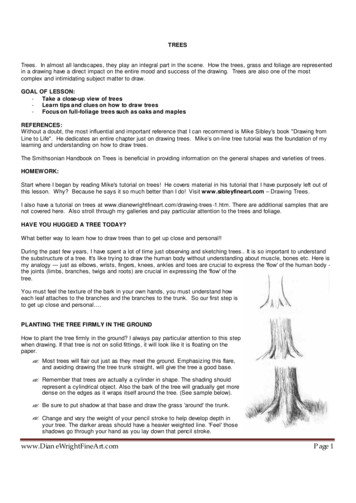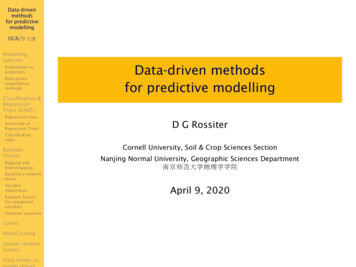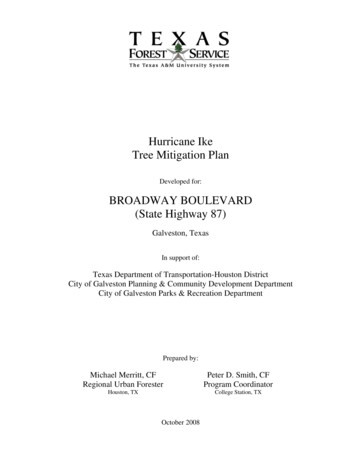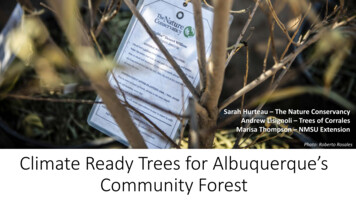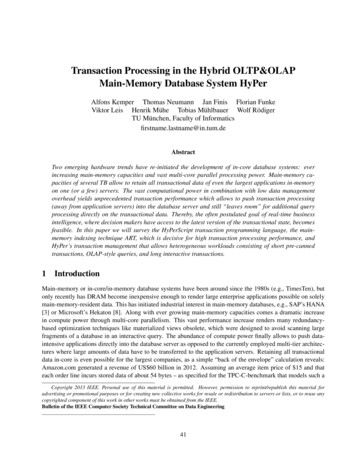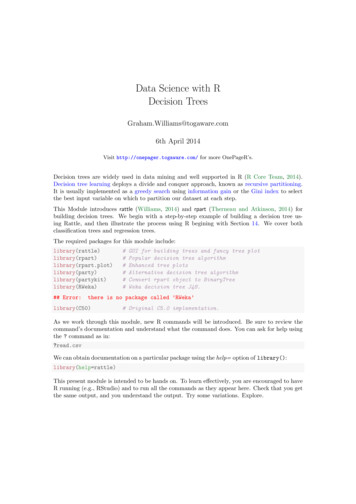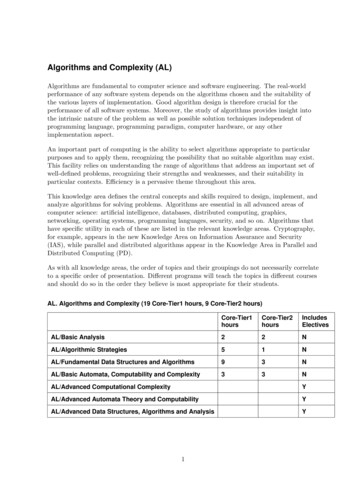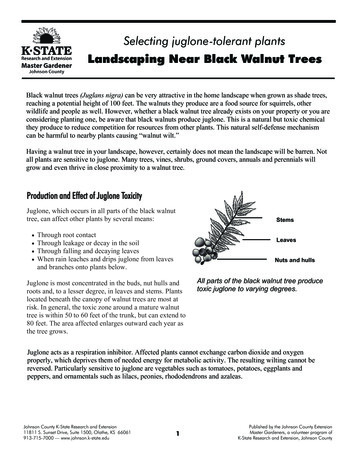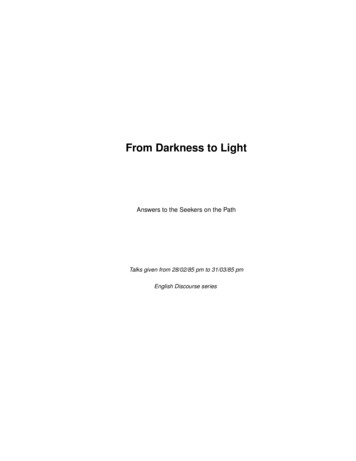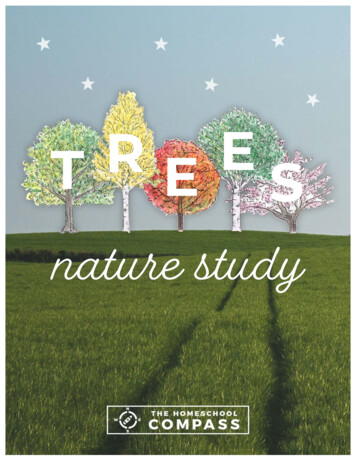
Transcription
ERT E Snaturestudy
TYPES OF TREESASH (fraxinus)Green and white ash are the m ostcom m onspeciesofash tree and can be found throughoutm uch ofthe Eastern United Statesand Canada.Otherspecieslike the blue ash,California ash,and Carolina ash arefound in the MidwestandSouthern states.These large shade treesgrow up to about70 feettall.Atone tim e theywere the m ostfrequentlyplanted tree in citiesacrossthe U.S.astheycangrow in a varietyofsoilconditionsand theyareforgiving ofthe pollution,salt,and otherchallenging conditionsfound in urban settings.Ash treesare known fortheiropposite branching,m eaning branchesandbudsdevelop directlyacrossfrom each otherin pairs.W hen looking foropposite branching,rem em berbudsorlim bsm aydie,so noteverysinglebranch orbud m aystillhave itsm ate.Ash treeshave com pound leaveswith 5to9leafletson each stem .Theycom m onlyhave grayish bark thatisfurrowed with a distinctpattern ofdiam ondshaped ridges.Ash seedsarefound in clustersofslender,paddleshaped wingsknown assam aras.Ash wood isstrong,lightweightand pliable,m akingitperfectforfurniture m aking,basketweaving,andproducing sporting goodslike baseballbatsandsnow shoes.ASPEN (populus)Mostofthe aspen treesin the United Statescanbe found in Utah and Colorado,although theyare scattered throughoutthe restofthe W esternStatesaswell.The Aspen isthe state tree ofUtah.Aspen treesrequirefullsunlightto produce seedsow well,so theyaretypicallyfound in openand grareaslike the slopesofm ountains.Theyare consideredpioneertrees,m eaning theyare one ofthe firstspeciesoftreesto spring up whereland hasbeen cleared ordisturbed.
Aspen treesoften dom inate the landscape in areasthatexperiencefrequentwildfires.Aspen leavesarerounded and have teeth along the edges.Theygrow inan interlocking fashion along a branch like the teeth ofa zipper.Aspenleavesm ove freelyeven in a verylightwind,giving a distinctive rustlingsound and m aking the aspen tree appearto trem ble.Aspen leavesturnadiantgolden yellow colorin the fall.Aspen treeshave sm ooth,palearbark thatgrowsdarkerand rougherwith age.The wood isverysoft.Itisoften processed into pulpform aking paper.Aspen treeshave sm all,hairyseedsthatare carried awayin the wind.Aspensgrow quickly,butlive fora relativelyshorttim e(about60 yearson average).BIRCH (betula)Birch treescan be found acrossthe NorthernUnited Statesfrom Alaska to Maine and asfarSouth asthe m ountainsofVirginia andTennessee.The W hite Birch isthe state treeofNew Ham pshire.Birch treesare anotherpioneerspecies.Theycolonize grassy,openspacessuch asabandoned farm land orareascleared bya fire.Theyprefercool,m oistsoilandoften grow in groupsoftwo orthree trees.Birch treeshave eggshaped leaveswith pointedtipsand teeth along the edges.Theygrow in aninterlocking fashion along a branch like the teeth ofa zipper.Birch treeshave sm ooth,white,paperlikebark thatpeelsfrom the tree.Theyhave tinyseedsthatgrow inside a narrow cone aboutthe size ofyourthum b.The seedsare scattered on the wind in thewintertim e.Birch treesgrow to be about60 feethigh and live foraround 60 years.Native peoplestraditionallyuse birch treesin canoem aking,with the tough,lightweightbark used to coverthe canoeam e.frCEDAR (cedrus)The Cedarisa coniferoustree closelyrelated to the firtree.Itisnativeto the W estern Him alayasand the countriesofthe Mediterranean regionsuch asLebanon,Syria,and Turkey.True cedartreesare notnative tothe United States,buttheyhave been broughtin overthe yearsasapopularornam entaltree.
The Cedarcan grow to around 100 feetin height,som etim eshigher.Ithasgreen needlelike leavesand brown conesthatdisperse wingedseeds.Cedarwood hasa distinctive spicyfragrance.Cedarwood andcedaroilare known torepelm oths,so cedarwood hasoften been used to m ake chestsorclosetsforstoringclothes.Cedarwood isalso extrem elydurable,m akingita good choice forconstruction work and furniturem aking.Resin derived from the cedartree hastraditionallybeen used form edicinalpurposes.In ancienttim esthe Egyptiansused cedaroilforem balming and cedarwood forbuildingcoffinsorsarcophagi.The Phoeniciansusedcedarwood forbuilding shipsand houses.sofLebanon are frequentlyThe cedarm entioned in the Old Testam entasa sym bolofwealth,luxury,and strength (forexam ple,2 Chronicles1:15).Cedarwood wasused in thebuilding ofKing David’spalace (2 Sam uel5:11)andKing Solom on’stem ple(1Kings5:6).COTTONW OOD (populus)The Cottonwood tree isa deciduoustree thatgrowsthroughouttheEastern,Central,and Southwestern United States.Itisthe state tree ofKansas,Nebraska,and W yom ing.Cottonwoodstend to grow bestinopen areaswith fullsun.Theypreferm oistsoilandcan often be found along stream sand creek beds.Cottonwoodsare often planted asshade treesorwindbreaks,so look forthem around fieldsandfarm houses.The Cottonwood can grow up to100 feettalland live m ore than 100 years.Cottonwood treeshave large,glossy,triangularshaped leaveswith toothed edges.The leavesm ake a distinctive rustling soundwhen a breeze blowsthrough.The Cottonwood tree getsitsnam e from thewhite fluffysubstance thatsurroundsitsseedpods.In the sum m erm onths,the ripe podsofthefem ale treesburstand release these fluffyfibersto bedispersed on the wind.Thisfastgrowing tree isaninexpensive source oftim berforproducing newspaper,palletsand shipping crates.
CYPRESS (cupressus)Cypresstreesgrow throughoutthe world.In the UnitedStatestheyare frequentlyfound nearpondsand wetlandsalong the Southern and Eastern coasts.Theyprefera warmclim ate and swam py,m oistsoilwith fullsunlight.The BaldCypressisthe state tree ofLouisiana.essisa coniferoustree with narrow,feathery,The Cyprevergreen leavesand brown woodyconesthatlook likenutsoracorns.Itsgracefulshape m akesita com m onornam entalchoice forgardensand parks.Cypresstreesareknown forproducing a lightweightand durable wood thatispopularwith carpentersand artists.Cypresswood isoftenused forfurniturelike tables,bed fram esand cabinets.Itisalso used in the construction ofshingles,siding,porches,andbarns.DOUGLAS FIR(pseudotsuga m enziesii)The Douglasfirisan evergreen tree thatisnative to the W estern UnitedStates.Itisthe state tree ofOregon and one ofthe m ostprevalenttreesin the PacificNorthwest.Douglasfirshave flat,shortneedlesthatare aboutan inch long anddark green in color.The bark on a fullygrown Douglasfircan be overa footthick.The barkisredbrown in colorand often hasdeep grooves.Douglasfirtreeshavereddishcolored cones.Each cone hasthreeprongedtonguescalled bractsthatstick outbetween thescales.The Douglasfirispopularwith forestersbecauseofitsrapid growth.Douglasfirsare com m onlyused forwood fram e house construction andforChristm astrees.NearlyhalfofallChristm astreesgrown in the United Statesare Douglasfirs.Itisnotuncom m on fora Douglasfirtoliveover1000 years.The oldestDouglasfironrecord grew nearMountVernon,W ashingtonound 1400 yearsold when itwasand wasarcutdown in1913.
EASTERN W HITE PINE (pinusstrobus)The Eastern white pine isnative to the United States.Itcan be foundthroughoutNew England and acrossthe UpperMidwest.Itsrange extendsasfarSouth asVirginia,North Carolina,andTennessee.Itgrowsbestin sandy,welldrained soil.TheEastern white pine isthe state tree ofMichigan.Thisee typicallylivesaround 400 yearsand can growtrm ore than 100 feettall.The Eastern white pine hasneedlesthatare bluegreen in colorand grow in bundlescalled fascicles.Each fascicle contains5needles.Itsconesarelongand narrow,usuallyabout3to6incheslong.Theyhave lightbrown paperyscalesand are oftened with stickypitch.coatThe Eastern white pine haspaperylightgraybarkthatgrowsdarkerin colorand m ore deeplygroovedasthe tree m atures.The wood ofthe Eastern whitepine islight,soft,and easyto use fortoys,crates,andm anyotheritem s.Native Am ericanshave long valued the Eastern white pine asacinalplantusing the innerbark,needles,and rootsto ward offm edicoughsand colds.The needlescan be boiled to m ake a tea thatsoothessore throats.The sap ofthe Eastern white pine isnaturallyantibacterial,so ithastraditionallybeen used to treatwoundsand cuts.ELM (ulm us)There are severalspeciesofelm tree nativeto North Am erica.These speciescan befound throughoutthe Eastern andMidwestern United Statesand into theSouth.The Elm isthe state tree ofMassachusettsand North Dakota.The elm isa deciduoustree with adistinctive um brella shaped canopythatprovideslotsofshade.Forthisreason,elm treesare often planted in parks,alongresidentialstreets,orin backyards.Elm treeshave ovalshaped leaveswith jagged edgesanda pointatthe tip.The leavesturn yellow inautum n.
The bark ofthe elm tree isgrayishbrown and hasdeep,rough ridgesand furrowsthroughout.Elm treesform sm all,round seedsenclosed ina paperycasing called a sam ara.The tim berofthe elm tree isstrong,butalso flexible,m aking ita good choice forproductslike ship keels,archerybows,and m usicalinstrum ents.HICKORY (carya)Hickorytreescan be found throughoutthe Eastern halfofthe United States.Hickorytreeslive about250 yearsandcan grow to be around 100 feettall.Hickorytreeshave long,narrow leavesthatgrow along each stalkin oppositepairswith one leafatthe veryend ofthestalk.The leavesin the finalpairattheend ofthe stalk willbe noticeablylargerthan the others.Hickoryleavesoften feelhairyonthe edges.The seedsofthe hickoryare nutsencased in a thickl.Manyspeciesofhickoryhave edible nutsthatshelare a valuablefood source.These include the shagbark hickory,theshellbark hickory,and the pecan tree.Hickorynutsare also anim portantsource offood foranim alssuch assquirrelsand deer.Thehickorytree producesa dense,shockresistantwood thatisgood forhandlesoftoolslike axesand shovels.Itisalso used infurniture andarchitecture.ew Jackson,the seventh Presidentofthe United States,wasgivenAndrthe nicknam e Old Hickorybythe m en who served underhim in the W arof1812because he wasastough asan old hickorytree.M AGNOLIA(m agnolia)The Magnolia tree isnative to the Southeastern United Statesandgrowsbestin a warm clim ate.Itisoften found on the edgesofswam ps,stream s,orotherbodiesofwater.The Magnoliaisthe state tree ofMississippi.The Magnoliaisbestknown foritsverylarge,fragrantflowers.In som especiesthese bloom scan grow up to 1footin diam eter.Magnoliablossom sare m ostoften white,buttheycan also be pink,red,purple,oryellow.
Magnolia treesare m edium sized,growing to beabout60 to 90 feettall.Magnolia treeshavelarge,pointed,dark green leaves.The leavesstayon the tree yearround.The bark ofthe Magnoliaisgrayand sm ooth.Magnolia bark hastraditionallybeenused foritscalming effects.Itisbelieved to help with sleep,anxiety,and stress.M APLE (acer)Maple treescan be found in alm osteverypartofthe United States.Som e ofthe m ostcom m on varietiesin Am erica are the sugarm aple,thered m aple,and the silverm aple.Altogetherthere are over132differentspeciesofm aple trees,m ostofwhich are native to Asia.Maplescanalso be found in Europe and Northern Africa.The sugarm apleisthestate tree ofNew York,Verm ont,W estVirginia,and W isconsin,whilethe red m apleisthe state tree ofRhode Island.Maplestypicallygrow to be around 60 feettallandcan live for300 yearsorm ore.Maple treeshavepalm ate(orhandshaped)leavesasseen onthe flag ofCanada.The winged seeds(orsam aras)ofthe m apletree resem ble the bladesofa helicopter.Theycan often be seen twirling to theground in sum m er.The sugarm apleistapped foritssap whichcan be boiled into m aple syrup.Maple woodisknown foritsbeautifulgrain and isfrequentlyused in flooring and furnitureproduction.OAK (quercus)Oak treesgrow alloverthe United Statesand throughoutthe restofthe Northern Hem isphere aswell.In 2004 the Oak waschosen astheOfficialNationalTree ofthe United States.Itisalso the state tree ofConnecticut,Georgia,Illinois,Iowa,Maryland,and New Jersey.
Depending on the species,oak treestypicallygrow from 40 to 80 feettall.On averagean oak tree lives100 to 300 years,although som e specim ensare thoughtto be over1000 yearsold.Oak leaveshave a distinctive lobedshape with rounded edgesand aleatheryfeel.Oak seedsare called acorns.These brown,round nutshave asaucershaped cap on the top.Am ature oak can produce asm anyas50,000acornsin one season.That’sabouthalfa ton ofns!In addition to sprouting new oak trees,acornsare an im portantacorsource offood foranim alslike raccoons,squirrels,foxes,rabbits,deer,and blue jays.Oak isa beautifuland hardywood,m aking ita greatchoice forconstruction,flooring,and furniture m aking.PALM (aceraceae)Palm treesgrow bestin hotregionsand can be foundthroughoutthe worldin tropicaland subtropicalclim ates.In the United Statespalm treesthrivein a,South Carolina,and Texas.The Palmisthe state tree ofFlorida,and the Palm ettoisthe state tree ofSouth Carolina.The differentspeciesofpalm treesvarywidelyin size.Forexam ple,coconutpalm swith theirlongslendertrunkscan grow to be 100 feettall.Otherpalm saresm allshrubsthatonlygrow to about6 feettall,and som edwarfpalm sare sm allenough to grow indoorsinaner.Som e typesofpalm shave fiberscovering thecontaitrunkswhich m akesthe trunk look hairyorspiky.Palmshave large evergreen leaves.Theycan be pinnate(featherlike)orpalm ate(fanlike)depending on the species.Coconutpalm sproduce coconutswhich are fibrous,singleseeded fruits.In the wild a coconuthasseverallayers:the sm ooth greenish outerlayercalled the exocarp,a fleshyhusk in the m iddle called the m esocarp,and ahard woodyshellcalled the endocarp.Inside the endocarpisthe white m eatofthe coconutaswellascoconutwater.
Beyond using coconutsforfood,palm treeshave m anyotheruses.Forexam ple,palm leavescan be used forthatched roofs,baskets,and clothing.Palm oilisusedforcooking.The wood ofthe palm tree isan im portantconstruction m aterialin m anypartsofthe world.PINE (pinus)Pine treesare tallconifersthathave scalybark andevergreen needles.Theyproduce pinecones.Thereare m anykindsofpine trees,such asthe easternwhite dine and Douglasfir,previouslydiscussed.REDW OOD (sequoia sem pervirens)Redwoodsonce grew throughoutthe northern hem isphere,buttodaytheyare onlyfound along the coastfrom centralCaliforniato southernOregon,no m ore than 50 m ilesinland.Redwoodsrequire plentifulwaterand have veryshallow rootsystem s,so the coolcoastalairand frequentfog in thisarea isessentialto keep the redwood forestsdam p and protectthe treesfrom dryspells.Theredwood isthe state tree ofCalifornia.Itisnotunusualfora redwood tolive for500 to1000 years.Theycan grow up to 24 feetin diam eterand over350 feettall. The tallestknown livingtree isa coastalredwood called Hyperion,whichwaslastm easured at380.1feettall.Hyperion’sexactlocation iskeptsecretto protectthe treefrom dam age.Redwoodsare nam ed fortheirthick,reddish brown bark.Theyhave tapered trunksthatgrow narrowernearthetop ofthe tree.The leavesofthe coastalredwood growin a coneshaped crown.In spite oftheirgreatsize,coastalredwoodshave tinycones,onlym easuring about1inch long.Coastalredwoodshave historicallybeen valuablefortheirtim ber.Due to heavylogging starting in the1850s,95% ofold growth redwoodshave been cutdown.Mostofthe redwoodsthatrem ain areinprotected forestsand parks.
SEQUOIA(sequoiadendron giganteum )The giantsequoia growsalong the western slope ofthe Sierra NevadaMountains,usuallybetween 5,000 and 7,000 feetabove sea levelandfarinland.Sequoia treesgrow atsuch high elevationsbecause theyrequire drym ountain airin orderfortheirconesto open and disperse theirseeds.Like the coastalredwood,atone tim e thegiantsequoia could be found throughoutthe Northern Hem isphere,buttodaytheyexistonlyin 77 grovesthroughoutNorthernCalifornia,m ostlyin protected parksandforests.Giantsequoiasgrow to be about30 feetindiam eterand m ore than 250 feettall.The largestliving tree byvolum e isa giantsequoia knownasGeneralSherm an.GeneralSherm an islocatedin Sequoia NationalParkin California and isestim ated to be atleast2,300 yearsold.The treem easures36.5feetin diam eteratthe base and274.9feettall.Giantsequoiascan live to be over3,000 yearsold,m aking them som e ofthe oldestlivingorganism son the planet.Similarto the coastalredwood,the giantsequoia hasrelativelysm allcones,onlyabout1to 3incheslong.One tree m ayproduce asm anyas11,000 cones.The wood ofthe giantsequoiaisnotgood fortim berasitisquite brittle and the treesoften break apartwhen felled.Nevertheless,the giantsequoia washeavilylogged aroundthe turn ofthe 20th century.W ALNUT (juglans)The walnutisa deciduoustree thatgrowsthroughoutm uch oftheEastern halfofthe United States.The m ostcom m on speciesin Am ericaisthe black walnut.W alnuttreescan tolerate m osttypesofsoilandpreferfullsun.The black walnutisan allelopathictree,m eaning itreleaseschem icalspoisonousto otherplantssuch asapple trees,pines,lilacs,and tom ato plants.Thistoxicityhelpsprotectthe tree from otherplantsencroaching on itsterritoryand helpsensure thatthe walnuttree can getenough sun.
W alnuttreesgrow to about50 to 75feettalland can live to around150 yearsold on average.Ittakesabout12to15yearsbefore the tree startstoproduce walnuts.W alnuttreesgrow verydeep roots,m aking them a difficultspeciesofee to transplant.trW alnuttreeshave toothed leaveswith a pinnate(orfeatherlike)shape with an odd num berofleavesattached to each stem .Thefruitofthe walnuttree isvaluableforfood.The US isthe world’ssecond largestoducerofwalnutsbehind China.The vastprm ajorityofwalnutsgrown forfood in Am erica arecultivated in the valleysofCalifornia.W alnutsarealso an im portantfood source forfoxes,squirrels,and woodpeckers.WILLOW (salix)The willow tree isnative to China,butitcan be found throughouttheNorthern Hem isphere.There are about80 differentspeciesofwillowsfound in the United States.Atleastone type ofwillow growsin each ofthe 50 states.Willow treeslike a lotofm oisture.Theyoften grow along riverbanksorakes.In som e partsofthe world,willow treeshavenearpondsand lbeen planted along waterwaysto preventsoilerosion because theirstrong rootshelp hold the soilin place.W illowscan also be planted inflooded areasthatneed to be drained.Willow treestypicallygrow to beabout30 to 60 iving around 50 to 60 years.The willow isa deciduoustree.Ithaslong,narrow leavesthatare green on the top andwhitish underneath.Theleavesturn yellow in autum nbeforefalling to the ground.
Willowshave a distinctive shape with flexible branchesthatbend downtoward the ground and swayelegantlyin the breeze.W illow leavesandbark have m anym edicinaluses.Traditionallytheyare used to treatfever,pain,and inflam m ation.YEW (taxus)The yew tree isnative to Europe,North Africa,Iran,and SouthwestAsia.The speciesofyew m ostcom m on in North Am erica isthe pacificyew,which growsalong the W estCoastfrom Alaska to California.The yewtree can grow in a wide range ofconditions:warm orcold,hum id ordry,and acidicoralkaline soil.eesgrow to be about30 to 60 feethigh.Theylive about400 toYew tr600 yearson average,although severalyew treesin the United Kingdomare believed to be over3,000 yearsold.Yew treesare evergreen.Theyhave flat,dark green,needlelike leavesand tinyseed cones.Each seed cone issurrounded bya brightred,fleshycovering called an arilthatresem blesa berry.The arilsare ofteneaten bybirdswhich then disperse the tough seed.sverydurable.In the Middle AgestheYew wood iEnglish used yew to m ake longbows.One ofthe oldestwooden artifactsin the worldisa spearhead m ade ofyew thatwasfound in Essex,United Kingdom andisbelieved to be 450,000 yearsold.
TREESflashcards
ashaspenbirchcedar
cottonwoodcypressdouglasfireasternwhitepine
elmhickorymagnoliamaple
oakpalmpineredwood
sequoiawalnutwillowyew
SHAPES OF TREESSPREADINGVASEWide and open treeswith splotchyshadeArching brancheson acentraltrunk,widestatthe topPYRAM IDALWide coneshaped treeswith a large trunk andhorizontalbranches;goodforChristm astreesROUNDCOLUM NAROvalshaped treeswithalarge trunk and densefoliage thatcreatesheavyshadeTalland thin treeswithuprightbranchesW EEPINGCharacterized byflexible,long branchesthathang down withcascading foliage
SHAPES OF TREESDraw a line from each tree to its shape:W EEPINGVASESPREADINGROUNDCOLUM NARPYRAM IDAL
SHAPES OF TREESCheck youranswers:W EEPINGVASESPREADINGROUNDCOLUM NARPYRAM IDAL
TREE twoods”Hasbroad leavesthatchange colorin the fallEvergreen (staysgreenallyear)Losesleavesin the winterto conserve energyHasneedlesand conesNeedsrich soilto growLotsofsunlightreachesthe groundCan be tallorshortCan grow in poorsoilLittle sunlightreachesthe groundUsuallytallProducesflowersand fruitDoesnotproduce flowersorfruitGenerallyround shapedGenerallyconeshapedExam ples:m aple,birch,ashExam ples:douglasfir,cedar,eastern white pine
DECIDUOUS VS.CONIFEROUSTREESLabelthe tree characteristics “C”forconiferorD for“deciduous”accordingly:Circle the deciduous trees:PineCedarCottonwoodAspenDouglas firEasternwhite pineSequoiaM agnolia
DECIDUOUS VS.CONIFEROUSTREESLabelthe tree characteristics “C”forconiferorD for“deciduous”accordingly:Circle the deciduous trees:PineCedarCottonwoodAspenDouglas firEasternwhite pineSequoiaM agnolia
LIFE CYCLE OF ACONIFER1.POLLEN CONE & SEED CONEPollen travelsthrough the airfrom the m ale pollencone up to the fem ale seed cone.The pollen grainentersthe pollen tube and fertilizesthe egg cell.2.FERTILIZED CONEThe egg cellsin the fertilized cone grow into seeds,which are dispersed into the wind.3.SEEDThe seed fallsinto good soiland growsinto a new plant,spreading rootsand beginning toform a stem .4.SEEDLINGThe seedling grows,carrying nutrientsthrough the trunk to the restoftheplant.5.M ATURE TREEOnce the tree isfullym atured,itform sitsownpollen and seed conesand repeatsthe process.
LIFE CYCLE OF ACONIFERPollen &seed coneTreeSeedlingFertilizedconeSeed
LIFE CYCLE OF ACONIFERLabeland draw each step ofa conifer’slife cycle:
LIFE CYCLE OF ADECIDUOUS TREE1.SEEDSeedscom e from treesproducing fruit.Theycanhave a protective shell,like the acorn ofan oak tree.The seedsare dispersed through wind,water,oranim als.2.SPROUTThe seedsthatland in conditionsfavorableforgermination willsproutand grow.The rootsgrow intothe soilto search forwaterand nutrients,and thesproutem ergesfrom the ground to find lighttobegin the photosynthesisprocess.3.SEEDLINGThe stem developsinto a trunk with itsown thin,protective bark.The seedling fightsfornutrients,water,sunlight,and space foritsrootsto grow.4.SAPLINGThe seedling growsinto a sm alltree calleda sapling,about4.5feettall.Atthisstagethe tree growsveryrapidly.5.M ATURE TREEOnce the tree isfullym atured,itproducesflowersand fruits.Itthen dispersesitsownseedsand repeatsthe process.
LIFE CYCLE OF ADECIDUOUS TREESeedSproutTreeSaplingSeedling
LIFE CYCLE OF ADECIDUOUS TREELabeland draw each step ofa deciduoustree’slife cycle:
ANATOM Y OF A TREELabelallthe parts ofa deciduous tree:BRANCHCROW NTRUNKLEAVESROOTS
ANATOM Y OF A TREELabelallthe parts ofa deciduous tree:
PARTS OF A TREE TRUNKOUTER BARKProtectsand insulatesthe tree aswellasregulating m oisture.INNERBARKPITHMovessugarysapto the rootstofeed the restofthe tree.CAM BIUMHelpswithoutergrowthCore ofthe tree;transportednutrientsto d each yearofgrowthSAPW OODHEARTW OODThirdlayerofvasculartissue,helpstransportssap to the rootsDead cellsthatstrengthenand supportthe trunk,storehouse forsugarsand oils
PARTS OF A TREE TRUNKLabelallthe parts ofa tree trunk:
FRUITS THAT GROWON TREESOrangeM angoAppleGrapefruitPom egranateLem hFig
TREES IN EACH SEASON(Deciduous)SPRINGSUM M ERThe tree startsgrowing andflowering,and sproutsnew leaves.The tree keepsgrowing andbearsfruit.FALLWINTERThe tree stopsgrowing,and the leaveschange color.The leavesfalloffto help thetree conserve energyin thecold weather.
M Y TREE IN SPRINGRecord observations ofone treein allfourseasons.
M Y TREE IN SUM M ERRecord observations ofone treein allfourseasons.
M Y TREE IN FALLRecord observations ofone treein allfourseasons.
M Y TREE IN W INTERRecord observations ofone treein allfourseasons.
CROSSW ORD PUZZLEACROSSDOW N5.Tropicaltree thatcan producecoconuts6.Dead cellsthatstrengthen and supporta tree trunk,storehouse forsugarsandoilseesstartgrowing and flowering9.Trin thisseason10.Outerlayerofthe tree trunk thatprotects/insulatesthe tree andregulatesm oisture13.Tree with reddishcolored conesanddark green needles4.Core ofa tree trunk116.Treesthatstaygreen allyearand cangrow in poorsoil1.Leavesofdeciduoustreeschangecolorin thisseason2.The state tree ofKansas,Nebraska,and W yom ing3.The step in the deciduouslife cyclewhere the seed growsrootsinto soilwto search forwaterand nutrients4.W illow treesare thisshape7.Thistype oftree haspeeling,white,paperlike bark8.A sm alltree thatgrowsrapidly11.Christm astreesare thisshape2.Thistree hassap thatcan be boiled1into syrup15.Conifers’seedscom e from fertilized
CROSSW ORD PUZZLEACROSSDOW N5.Tropicaltree thatcan producecoconuts6.Dead cellsthatstrengthen and supporta tree trunk,storehouse forsugarsandoilseesstartgrowing and flowering9.Trin thisseason10.Outerlayerofthe tree trunk thatprotects/insulatesthe tree andregulatesm oisture13.Tree with reddishcolored conesanddark green needles4.Core ofa tree trunk116.Treesthatstaygreen allyearand cangrow in poorsoil1.Leavesofdeciduoustreeschangecolorin thisseason2.The state tree ofKansas,Nebraska,and W yom ing3.The step in the deciduouslife cyclewhere the seed growsrootsinto soilwto search forwaterand nutrients4.W illow treesare thisshape7.Thistype oftree haspeeling,white,paperlike bark8.A sm alltree thatgrowsrapidly11.Christm astreesare thisshape2.Thistree hassap thatcan be boiled1into syrup15.Conifers’seedscom e from fertilized
used used for wood frame house construction and for Christmas trees. Nearly half of all Christmas trees grown in the United States are Douglas firs. It is not uncommon for a Douglas fir to live over 1000 years. The oldest Douglas fir on record grew near Mount Vernon, Washington aand was around 1400 years old when it was cut down in 1913.

